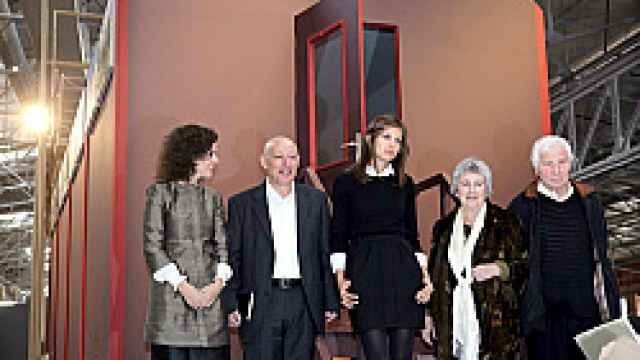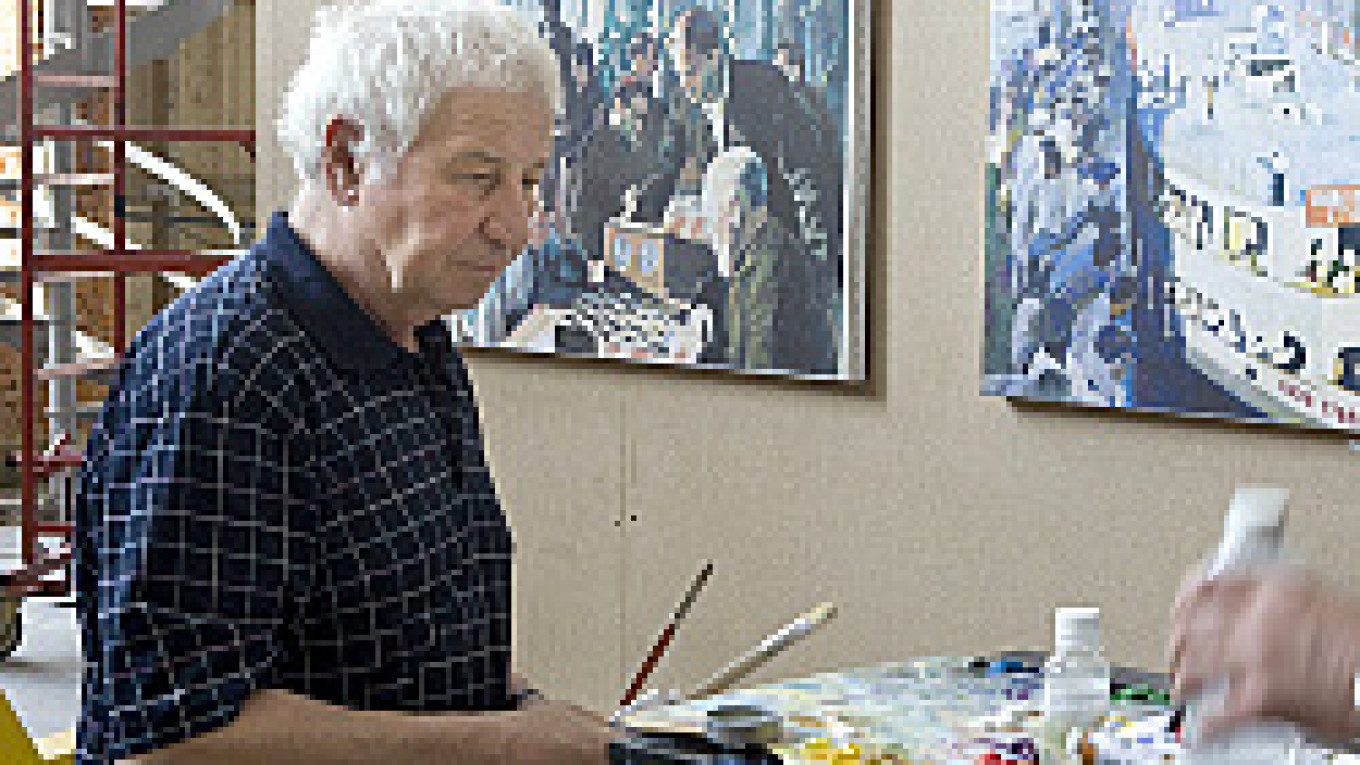Despite their monstrous numbers, the security guards go almost unnoticed in the lofty foyer of the former Bakhmetyevsky Bus Garage, where visitors' eyes are instantly drawn upward to take in the vast space.
"When I saw the place it was like love at first sight," Zhukova said in an interview a few days before the opening. "It looked incredible from the outside, and luckily I had a chance to go in."
Zhukova was heavily made up with tight jeans, a gray blazer with military details, and black knee-high boots. She spoke with a heavy American accent, and refused to comment on anything other than the Garage and its present condition.
Zhukova took over the lease of the Konstantin Melnikov's constructivist landmark from the Federation of Jewish Communities just six months ago. She came up with the idea of transforming it into the Garage Center For Contemporary Culture.
The gallery was described as a non profit exhibition space that would be open to everyone. But in June it had a glitzy opening ceremony which was invitation-only. Amy Winehouse performed and invited guests viewed a small exhibition dedicated to Melnikov and a light installation by Mexican-born artist Rafael Lozano-Hemmer.
Now the 8,500-square-meter space has opened to the public with an exhibition from two of the most prominent figures in Russian contemporary art, Ilya and Emilia Kabakov. The Kabakovs are visiting Russia for only the second time since they emigrated to the United States in the 1980s.
Their work is being displayed simultaneously at three exhibitions in central Moscow. The largest exhibition is at the Garage, while Winzavod and the Pushkin Museum of Fine Art are hosting smaller shows.
Ilya Kabakov was born in Soviet Ukraine in 1933 and studied art in Moscow. He worked as an official artist, illustrating children's books, but became involved in the underground art scene. In the 1970s, he co-formed an art group called The Moscow Conceptualists. In the late '80s he emigrated to New York and continued to work with his wife, Emilia.
"Ilya never officially emigrated. He just came over here to see an exhibition and never came back," Emilia Kabakov said, laughing.
She is the spokesperson for the couple. Talking to journalists "makes Ilya nervous," she said.
By the time the couple came back to Russia to exhibit in the Hermitage in 2004 they were known worldwide for their installations, which gave a glimpse into life in the Soviet Union.
One of these works, "Red Wagon," sits in the foyer of the Garage. It is a railway car painted inside with a mural of idyllic Communist life. A sound system plays nostalgic Soviet music. But the entrance is blocked by a pile of rubbish, and a ladder on the roof leads to nowhere.
 Igor Tabakov / MT Mollie Dent-Brocklehurst, Joseph Backstein, Daria Zhukova, Emilia and Ilya Kabakov at the Garage launch on Tuesday. | |
In 2006, when the Bakhmetyevsky garage was under the lease to the Federation of Jewish Communities, the Kabakovs arranged to use the space for their exhibition.
"We had everything ready and planned for over a year, then all of a sudden there was an announcement that Dasha would be creating a center of contemporary art. We thought, 'This will be a disaster,'" Emilia Kabakov said. "She approached us with plans, and what was amazing was that all her plans were drawn around our plans."
"What you're seeing now, is not finished," Zhukova said of the Garage. "I just knew about the Kabakov retrospective, and I had a deadline to work toward."
The Kabakov exhibition was funded by Roman Abramovich through Zhukova's Iris Foundation. The complex project involved the construction of a 23-room enclosed gallery inside the Garage. The rooms have sombrely painted walls and suspended plasterboard ceilings.
The gallery within a gallery houses a fake retrospective of Russian art titled "Alternative History of Art." On display is the work of three artists who have been invented by the Kabakovs. The paintings, a blend of impressionism and Socialist Realism, were clearly drawn by the same hand.
"This exhibition is a work of fiction; it's a 'what if?'" Emilia Kabakov said. "What if instead of Kandinsky and Malevich, you had the artists Kabakov, Rosenthal and Spivak?"
Just like in a real gallery, the artists' life stories are printed on the walls. Charles Rosenthal died prematurely in the early 20th century, while Rosenthal's work came chronologically after Kazimir Malevich. His paintings were optimistic, and he believed in the idea of a Soviet utopia. Kabakov (an alter-ego of Ilya Kabakov) adhered to the principles of Rosenthal but became disillusioned by Soviet ideals, and his work is often obscured by geometrical shapes and surrounded by murky colors.
Igor Spivak, the third artist, created his works in the 1990s in a mood of nostalgia for the Soviet Union. "He believes that all the good things are behind him," Emilia Kabakov said, describing him as "a drunk who has only finished 17 works."
Most of Spivak's works are painted in patriotic red. Some are unfinished with pencil lines that dictate where the paint is to be applied. One large canvas, dedicated to a metro theme, depicts two small red rectangular images floating in white space. One is of a crowd standing on the escalators wearing their winter clothes, they have serene expressions.
Unfortunately, the gallery installation within the Garage disguises rather than accentuates the evocative space. The enclosed rooms block the light coming through Melnikov's circular windows and hide original architectural details such as the helix-shaped staircases and the dramatic roof.
In a month, the exhibition will be dismantled and architect Jamie Forbert will complete the transformation of the garage. Next to the exhibition space there will be a bookstore, caf??, lecture hall, a library and a small cinema.
When the Garage reopens in February next year, Zhukova plans to hold a series of workshops for adults and children. French billionaire Francois Pinault, whose holding company owns Christie's auction house, will exhibit some of his collection. Molly Dent-Brocklehurst, a former dealer at the Gagosian Gallery will be overseeing the center.
"Alternative History of Art" and "Red Wagon" runs to Oct. 19 at The Garage Center for Contemporary Culture located at 19a Ulitsa Obraztsova. Metro. Mendeleyevskaya. Tel. (499) 503-1038.
A Message from The Moscow Times:
Dear readers,
We are facing unprecedented challenges. Russia's Prosecutor General's Office has designated The Moscow Times as an "undesirable" organization, criminalizing our work and putting our staff at risk of prosecution. This follows our earlier unjust labeling as a "foreign agent."
These actions are direct attempts to silence independent journalism in Russia. The authorities claim our work "discredits the decisions of the Russian leadership." We see things differently: we strive to provide accurate, unbiased reporting on Russia.
We, the journalists of The Moscow Times, refuse to be silenced. But to continue our work, we need your help.
Your support, no matter how small, makes a world of difference. If you can, please support us monthly starting from just $2. It's quick to set up, and every contribution makes a significant impact.
By supporting The Moscow Times, you're defending open, independent journalism in the face of repression. Thank you for standing with us.
Remind me later.


